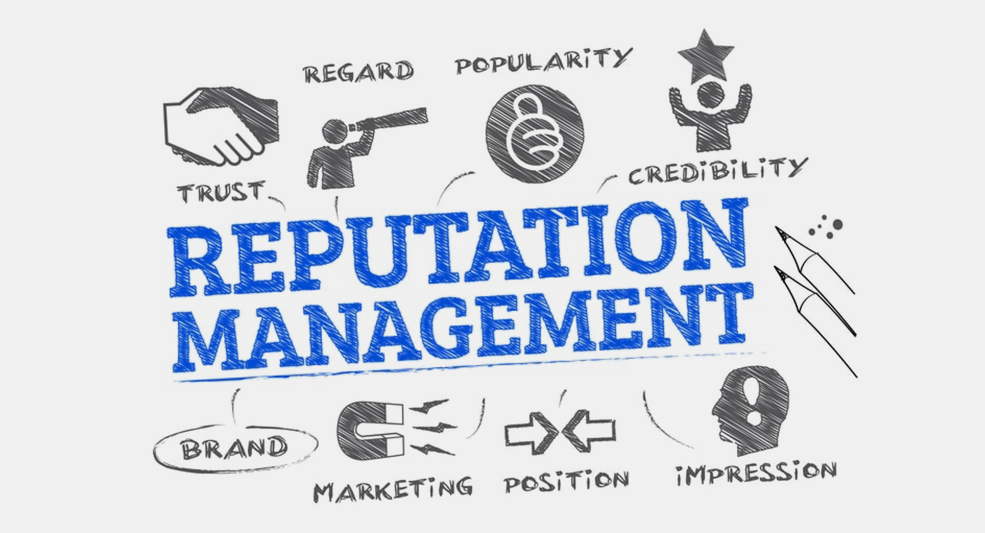Did you know?
- 39% of customers trust brands only if they engage with them on social media platforms.
- More than 76% of Americans made a purchase after seeing a brand’s social post.
- 70% of social media users are likely to recommend a brand to friends and family after a positive experience with the brand.
From the beginning of time, brands have been concerned with image and reputation. But in the 21st century, when every little grumble results in a viral YouTube video, brand reputation management has become crucial to survival.

Today’s B2B brands must be more vigilant than ever about managing their reputation. A misstep can cost not only prospective customers but also investors, suppliers, and even employees.
To help you steer clear of the most common mistakes and to pay special attention to your brand’s reputation at all times, here are seven pillars of Brand Reputation Management.
1. Listen to Your Market.
The first pillar of B2B brand reputation management is to listen. Listening can mean a lot of things and it’s not just about hearing words. You also need to be listening for actions, emotions, and motivations behind those actions, emotions, and motivations. Moreover, you must be able to hear what your customers, prospects, competitors, employees, partners, and suppliers are saying or not saying about you in order to understand what they need from you now or in the future – this will help you develop products/services that meet these needs better than any other competitor out there who doesn’t take their time doing research
2. Shape the Conversation.
As you’ve learned so far, B2B brand reputation management is about shaping your company’s image in the marketplace by controlling and managing social media conversations. In this section, we’ll explore seven pillars of shaping the conversation:
- Focus on the customer: It’s easy to get caught up in internal politics or think too narrowly about your own development. But if you want people to buy from you, they need to trust that they will be satisfied (or even pleased) with what they receive. That means paying attention to what customers are saying about their experiences with your product or service, and acting quickly when there is the feedback that needs addressing.
- Be proactive: If something goes wrong for one of your customers, reach out immediately and sincerely apologize for any inconvenience caused by whatever problem occurred (whether it was due to your company’s fault or not). If a customer has a question about something related but tangential to their experience with your business, answer those questions promptly without making them feel like an annoyance.
Remember: people respond more positively when companies take responsibility for their actions than when those same companies try deflecting blame onto someone else
The most successful companies recognize that B2B brand reputation management isn’t just about controlling what others say. It’s also about guiding how conversations happen between customers and prospects online through proactive measures such as writing blog posts regularly. Let people know where they can go if they have questions/concerns related specifically.
3. Monitor Your Competition and Other Repurposing Opportunities.
It’s important to monitor what your competitors are doing on social media, in the press, and online so that you can be one step ahead of them or at least avoid any major PR problems.
Use tools like Google Alerts, Google Trends, Mention (a social media search tool), Buzzsumo (a competitive analysis tool), Social Mention (which tracks mentions of brands or topics), and Hootsuite to track conversations about your brand on Twitter; Facebook; LinkedIn; blog posts; forums like Reddit or Hacker News; Instagram post comments; YouTube comments; etc
4. Respond to Aggressive Comments with Minimum Arrogance.
Always respond to onslaughts with a maximum of clarity and a minimum of arrogance.When you do something that sends your customers into an uproar, the best thing to do is be clear about exactly why you did what you did. Don’t be arrogant or defensive about it.
Instead, try to approach the situation with humility and respect for both your customers and competitors. Treat them all as equals and explain how their concerns are valid. If it’s possible for you to reverse course or make amends, do so quickly and humbly. Don’t wait until things get out of hand.
Be respectful but firm, because no one wants to deal with someone who is all talk but no action. This principle is also important when dealing with employees who have been let go by the company. Make sure they’re treated fairly and kindly during their transition period so they can meet new opportunities on their own terms.
5. Invite Your Customers to Tell Their Story.
The fifth pillar of B2B brand reputation management is inviting your customers to tell their stories. Don’t just ask them to give you a testimonial; ask them to submit case studies as well.
Case studies are great because they paint a picture of your customer’s experience with your company, and they are typically more detailed than simple reviews or testimonials. If you request case studies from customers, be sure that you have the capacity to publish them on your website or in an industry magazine.
Additional Tip: Don’t forget that timing matters when posting paid content online. So post new articles during peak hours (like lunchtime) since these times usually attract more readers than usual.
6. Manage Paid Content and Display Advertising Wisely.

Paid content and display ads should be relevant to your business and relevant to your target audience. If you’re a financial services firm, publishing an article about the latest “IT” isn’t going to help you make money and it could actually hurt your reputation. Likewise, if you sell luxury cars, there’s no reason for you to be advertising on a website with news about local food trucks.
Paid content should also have high-quality writing that is engaging and well-designed; this goes for display ads as well. While many companies think of paid content as something they can slap together without much effort, this isn’t true at all.
Your paid content needs to be just as good as anything else that goes out over your brand’s name because people are going to see it and judge whether or not it belongs with the rest of what they know about your company through other channels like social media profiles or online reviews.
7. Be Honest About Your Strengths and Weaknesses.
When you’re honest about your strengths, your weaknesses and the strengths and weaknesses of others, you gain a competitive advantage. That’s because people can trust you when it comes to sharing information about your company, products or services. If customers know that you have their best interests at heart, they’ll be more likely to buy from you.
This is important for B2B brands because so many companies compete in similar industries where product quality is the main differentiator between competitors. In those cases, reputation becomes even more important than price.
For example: if I buy from Company A vs Company B and experience an issue with my purchase that affects its performance after delivery – which company am I going to go back to? The one that was honest about its product’s limitations
Example: “We’ve found this product doesn’t work well with certain non-standard fixtures”) vs the one who said nothing before selling me something they knew wasn’t good enough?
That’s why honesty matters so much.
To implement this pillar of reputation management make sure you understand what drives your customer base:
What do they value?
What motivates them?
How can you retain those who are unhappy with the company?
Additional Tip: Get feedback from employees about how well their needs are being met by the organization’s policies and procedures for hiring new talent or giving raises when needed. This can help keep everyone happy at work!
Key Takeaways
A solid reputation management strategy could be the difference between survival and extinction in today’s market. To succeed in today’s market, you need a solid reputation management strategy that addresses all seven pillars.
The first pillar, financial growth and stability, is often the most important factor when it comes to brand identity. But if you don’t have a strong relationship with your customers, employees and other stakeholders and if they don’t trust your company won’t survive.
This is an exciting and challenging time for B2B companies. The internet has opened up new opportunities for marketing, but it has also created a whole new world of complexity in terms of how you build your brand. And all this comes at exactly the moment when your company’s survival is more important than ever.
At the same time, we believe that your long-term success requires a commitment to a strategic approach to reputation management that includes everything from listening carefully to what consumers are saying about their needs and desires (as well as about you) to sharing positive stories about your brand with the world at large. We hope we’ve provided you with some useful tips along these lines.
